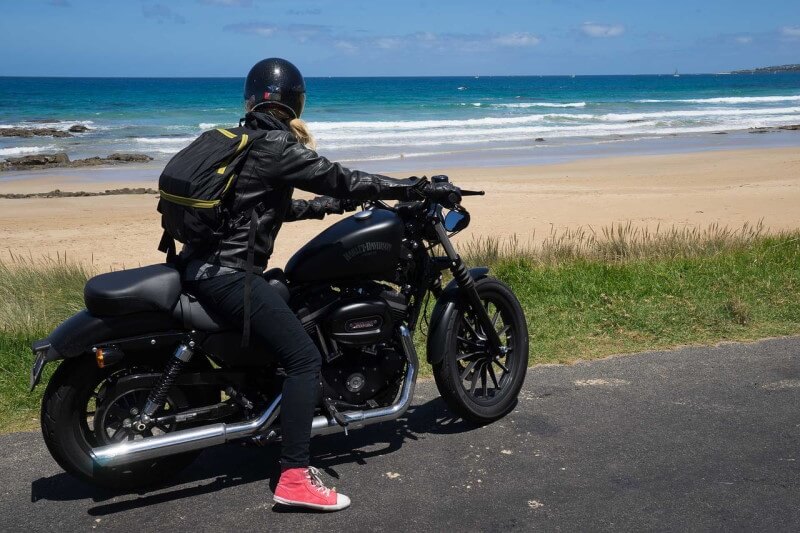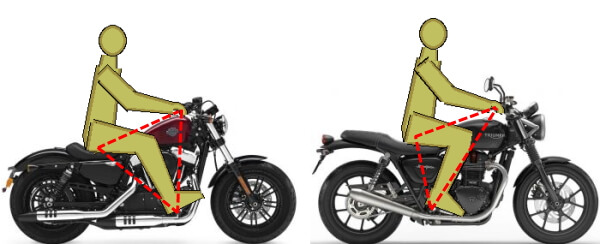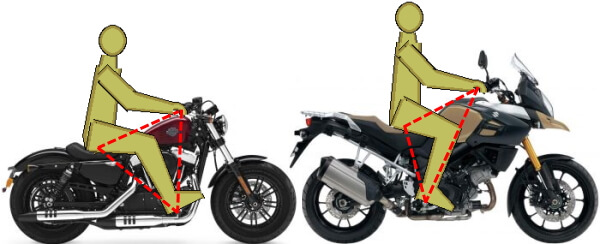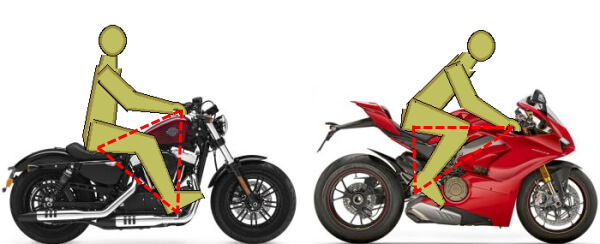
Long Distance Riding on Cruisers—The Good, Bad & Not Pretty
A while ago, my wife and I were talking about what motorcycle would be good for her to ride on a 2000-mile road trip that we were planning. As someone new to riding, she found cruisers appealing because of their low seat-height. Ultimately, she decided to ride as a pillion with me rather than get her own bike, but her questions inspired me to write this post: their marketing image aside, are cruiser motorcycles really good for long distance rides?
Cruisers can be pretty good on highways, generally offering better fuel range and comfort than sportbikes and most standard motorcycles. However, the low seat-height on cruisers means visibility is not great, and cruisers aren’t the best for bumpy / off-road conditions.
We’ll talk about the merits of cruisers for long rides in more detail, but first, let’s run through the attributes of a motorcycle that are important to riding long distances, and what, exactly, constitutes a "long distance" ride.
How Long is Long Distance?
If you ask a dozen motorcyclists what they think of as a “long distance” ride, you’ll probably get as many answers. I know a guy who goes out for a ride on his bike every Sunday and posts pictures on social media. His rides average around 100 miles each, and he considers that to be long distance enough for him (hashtag touring, hashtag riderlife, etc etc).
Meanwhile, there are riders who’ve ridden from Alaska to Argentina, and others still who’ve ridden all the way round the globe. As the saying goes, your mileage may vary. But most riders would agree that spending more than 5 or 6 hours a day in the saddle is fairly long.
Evaluating trip length in terms of riding time rather than distance actually makes sense, because the distance you cover depends on external factors such as traffic, weather, and road conditions. But even if you only cover 50 miles in 5 hours, you’re still not going to be any less exhausted.
Assuming an average speed of around 50 MPH, I’d say that any ride extending more than 200 - 250 miles (or 4 - 5 hours of riding) per day, qualifies as long distance riding. The reasoning for this is that distances or durations less than this can be covered fairly effectively on pretty much any contemporary motorcycle, regardless of what type of motorcycle it is. Beyond that point, the effects of a motorcycle that isn’t optimal for such long hours / miles, will begin to show up as rider fatigue.
If you’re planning to ride less than that, or even just one or two days of slightly longer rides, you’ll be fine on pretty much any motorcycle, and definitely fairly comfortable on a cruiser. But let’s look at how things stack up for cruiser rides if you’re planning distances greater than that.
What Makes Long Rides Better?
In any discussion on long distance riding, I think it’s important to acknowledge one basic fact: you can ride all the way around the world on virtually any motorcycle. As long as it’s got two wheels and goes more or less toward the direction you point it when you twist the throttle, you’re all set to ride it as far as you’d like.
There are plenty of people who’ve toured the whole world on nothing more than a 50-cc moped (like this guy). In fact, the whole notion of different types of motorcycles specially designed to take on different roles, like racing, commuting, touring, riding on dirt, and so on, is a relatively recent development in the overall timeline of motorcycle history.
So when I say that a certain bike is good for touring, that isn’t to suggest that you can’t ride long distances on something else. With that in mind, just remember that what makes for a good bike for riding long distances depends not just on the motorcycle, but also on you and your preferences as a rider.
For instance, I personally love bikes that are so smooth and refined that there are never any vibrations from the engine, regardless of how fast or slow I'm going. But I also know plenty of riders who dislike “excessive” smoothness, finding such bikes to be “boring”. Many of them say that some amount of vibration is necessary in order for them to find the bike engaging.
That said, there definitely are attributes that make a bike more suited to long distance riding. The most important ones are:
- comfort (riding position, refinement, and roominess)
- range
- handling
- power
The extent to which each of these attributes matters depends on how far you plan to ride, and of course, as I said earlier, on your preferences. So how do cruisers perform on each of these parameters?
What’s the Secret to a Comfy Ride?
The problem with talking about comfort is that it can be a pretty subjective thing. I find the seat on my cousin’s KTM to be painfully uncomfortable, while he likes it more than the seat on the Bonneville, which I think is superbly comfortable.
Which brings me to an extremely important point: before you choose a bike for you to ride, sit on it. Not just for 5 or 10 minutes at the dealership, I mean for a solid 45 minutes to one hour. Go on a long test ride, or rent or borrow the bike from someone if you have to. I know a shocking number of riders who just get a bike based on a very brief impression of it, and later have issues with the way the bike fits them.
While we’re on the subject of seats, cruisers tend to have pretty good ones. I remember noticing that the seat on the Street 750 is superbly plush, even though it’s Harley Davidson’s lowest-priced, entry-level bike. (It might be a bit too plush for very long rides however, as super-soft seats tend to create hotspots by letting you sink in too much.)
Generally speaking, cruiser seats are more comfortable than the seats that most standard and sport motorcycles tend to have. The most comfy motorcycle seats I’ve ever experienced though, are on adventure bikes.
But there’s a lot more to motorcycle comfort than just the seat. In fact, even more important than the seat, is the ‘rider triangle’ -- the triangle that’s formed by connecting the seat, the footrest and the grips on the handlebar, with three straight lines. Which is just motorcycle-designer-speak for your sitting position on the bike. The images below from the incredibly useful cycle-ergo.com demonstrate this perfectly.
 |
| Rider Triangle / Ergonomics: Cruiser vs Standard Motorcycle. Image Cycle-Ergo |
 |
| Rider Triangle / Ergonomics: Cruiser vs Adventure Motorcycle. Image Cycle-Ergo |
 |
| Rider Triangle / Ergonomics: Cruiser vs Sportbike. Image Cycle-Ergo |
The images compare the rider triangle on the Harley Davidson Forty-Eight, a pretty popular cruiser, to the sitting position on a standard, adventure touring, and sport motorcycle (in this case, the Triumph Street Twin, the Suzuki V-Strom, and the Ducati Panigale V4, respectively.)
The two most important factors here are the forward lean angle (how far forward you have to lean to reach the handlebar), and knee angle (how much your knee is bent when you’re seated with your foot on the footpeg). For long distance comfort, forward lean angles close to zero, and knee angles close to 90 degrees, are best (unless perhaps you have a medical condition which makes some other sitting posture better for you).
| Harley Davidson Forty-Eight | Triumph Speed Twin | Suzuki V-Strom | Ducati Panigale V4 | |
| (cruiser) | (standard) | (adventure) | (sport) | |
| Forward Lean Angle | 9.0 | 10.0 | 3.0 | 42.0 |
| Knee Angle | 124.0 | 78.0 | 91.0 | 69.0 |
| Hip Angle | 75.0 | 77.0 | 92.0 | 54.0 |
Assuming a rider height of 5 foot 9 inches, which is an average American height, the table shows how the four different bikes compare -- and these are fairly representative of the bikes in their class. As you can see, the cruiser is a pretty comfortable bike to be on. Some standard and adventure bikes can offer a more neutral riding position, which is preferable because it allows more flexibility for you to move around and change your posture.
Besides the rider triangle, two other attributes that influence comfort the most, are “NVH” and ride quality. “NVH” stands for noise, vibration and harshness, which is a measure of the “smoothness” of a vehicle. When people describe a certain car or bike as being very “smooth” or “refined”, what they usually mean is that the NVH levels are very low.
NVH levels vary widely from cruiser to cruiser. Japanese cruisers such as the Honda Shadow and the Kawasaki Vulcan, have a reputation for having much lower vibrations than their American counterparts, though there are exceptions.
On the noise front too, how much noise you can expect from the engine and from windblast (wind alone can contribute up to 80 decibels of noise or more, at highway speeds), varies based on model. Faired bikes typically have lower windblast on the rider than naked cruisers, but windscreens can do a pretty amazing job of cutting down windblast. And thanks to noise regulations, most cruisers of comparable displacement produce a comparable amount of engine and exhaust noise (unless you modify the exhaust with an aftermarket exhaust)
A lot of riders actually like the characteristic vibrations from the big V-twin Harleys, so if that’s something that you love, you may want to disregard NVH assessments. (Just be aware that research shows that prolonged exposure to high NVH levels has adverse health effects, ranging from discomfort and fatigue, to chronic back pain.)
And lastly, ride quality. On this count, cruisers are somewhat at a disadvantage compared to standard and adventure motorcycles, because of being so low to the ground. The low ride-height on cruisers limits the amount of suspension travel (the maximum distance that the spring can compress or elongate). This in turn restricts how their suspension can be tuned without bottoming out.
Despite this, fairly high-end cruisers such as the Harley Davidson Road Glide and the Honda Gold Wing, offer superb ride quality. However, on less expensive cruisers, it isn’t uncommon to hear complaints about the ride quality being less than stellar, especially on rough and bumpy roads.
How Far is the Next Gas Station?
Having to stop four times to refuel in a single day’s ride can be inconvenient. Besides, sooner or later, you’re going to want to head to a destination that’s pretty far away from a gas station. Of course, you can always carry some fuel in a jerry can to extend your fuel range, but it’s way more convenient if your bike just has decent fuel capacity.
Keep an eye on this when you’re choosing a cruiser for a long ride, because it differs based on model. The Honda Rebel 300, for instance, has a ridiculous 2.95-gallon gas tank, while the Yamaha Bolt R-Spec offers a middling 3.5 gallons, and the Indian Challenger offers an impressive 6-gallon tank.
How much fuel range is enough? Well, the endurance of the average rider is around 3 hours of non-stop riding. With experience, that could stretch up to 4 hours. Anything beyond that is uncommon. Assuming an average speed of around 40 to 50 MPH on US roads, that gives us a distance of around 150 to 160 miles. If your bike has that much fuel range, then you should be okay. Unless you’re heading off to explore the Atacama, in which case you probably shouldn’t be taking a cruiser anyway.
To Scrape Pegs or Not to Scrape Pegs?
What attracts a lot of motorcycling beginners to cruisers, is that cruisers appear to be easy to handle. This is mainly because of the low seat-height. It does inspire confidence when you sit on a motorcycle and you can comfortably reach the ground with both feet -- no tippy toes or leaning to a side. But the thing is, when you’re actually riding the motorcycle, your feet aren’t on the ground (hopefully).
So, the advantage of a low seat-height comes with a variety of disadvantages:
- footpegs may scrape the road easily in banked turns
- chassis may scrape the road over speed bumps
- ground clearance makes off-road riding difficult and potentially damaging to the bike
- rider sits low and closer to the road, limiting visibility, both of the road, and of the rider to other traffic
The other thing that’s characteristic of cruiser design, is the relatively high rake angle that gives them their characteristic “laidback” feel. The flipside of this is that it makes cruisers more difficult to turn. Compared to other types of bikes, cruisers tend to have a wider turning radius and more resistance to leaning into turns. This makes them slightly less easier to handle around twisty roads and tightly banked turns.
The longer wheelbase of most cruisers also gives them a slight fishtail tendency under braking, especially if they don’t have ABS. In contrast, standard motorcycles are easier to handle and more forgiving of rider mistakes through turns. And while we’re on the topic of ease-of-use, watch out for weight. Larger cruisers can weigh in excess of 800 pounds, and that can be extremely difficult to manage if you ever have to lift or push your bike.
Can You Ever Have Enough Power?
There’s a reason why I put power at the bottom of this list. I don’t think it’s as important as most riders nowadays make it out to be. Look, there are people who are doing around-the-world expeditions on foot. That’s even less than one horsepower. Do you really think that that guy isn’t having an adventure of a lifetime, just because he isn’t averaging 100 MPH?
Look, I get it, not all of us have the luxury of spending 7 years to travel the world. When all you have is that one weekend, you’d like to be able to actually get to the beautiful destination, rather than just spend most of your time sitting in traffic on the freeway. And when you’re overtaking or cruising down the interstate, you don’t want to be sitting at redline RPM just to keep up with the speed limit.
But how much power do you really need to cruise and overtake comfortably? Even a Yamaha V-Star 250 will still do the legal speed limit, and it has just 20 horsepower. Admittedly, that can be too little especially for two-up touring with luggage. That said, if you’re going to be sensible, on most motorcycles, anything over around 50 to 60 horsepower should be enough for you to go plenty fast (except perhaps if you’re planning to tow a trailer or sidecar).
Don’t become a spec-sheet-number-chaser like so many motorcycle journalists, reviewers and riders these days, who go around shaking their head at how 90 horsepower in a motorcycle that weighs less than 500 pounds, is “not enough”. Unless you’re racing on a track and have aspirations of becoming the next Valentino Rossi, chasing horsepower numbers is just nonsense.
Summary (or, Don’t Worry, You’ll Be Fine)
If you’re new to motorcycles, all this might seem like a lot to process. I just want to reassure you that as long as you ride safely and sensibly within your skill level, you can have fun on pretty much any motorcycle. Of course, it’s probably a good idea to start with a couple of short trips first, before you set off on some kind of trans-continental tour. But you knew that already. (Right?)
Cruisers offer above-average comfort when it comes to seats and riding position. But on refinement and ride quality, they’re a mixed bag; some cruisers are better than others, but most aren’t as good as your average adventure tourer. Many cruisers deliver decent fuel range -- just check the tank capacity and fuel consumption on any model you choose.
Handling is the one below-average area for cruisers. Standard and adventure bikes generally both handle better, and the higher seating position offers you improved visibility, which is an important safety advantage.
That said, if you’re really keen on cruisers and you love the way riding a cruiser makes you feel, just go ride one! As long as you take all the precautions you can, (wear your helmet, use high-vis safety gear, follow all traffic regulations, and so on) and plan ahead for your trip (weather, supplies, road conditions), you’ll have a great time.
If you’re not crazy about cruisers, however, I’d suggest you get a standard motorcycle, or an adventure tourer, if one takes your fancy. Preferably, choose a bike that’s relatively lightweight, like a Ducati Scrambler Icon (standard) or a KTM 390 Adventure.
I hope you found this post helpful. Disagree, concur, or have a question? Just leave a comment below! (I respond to every single comment).
